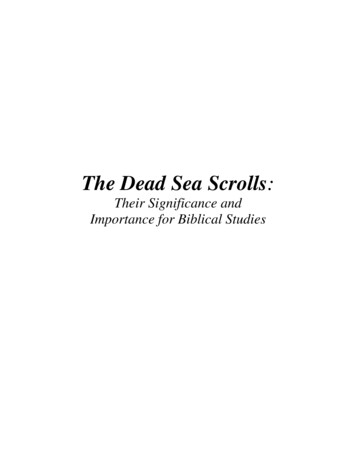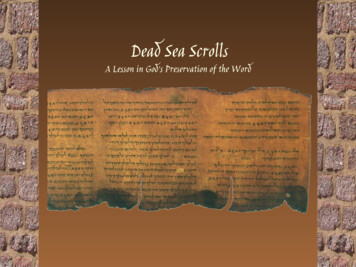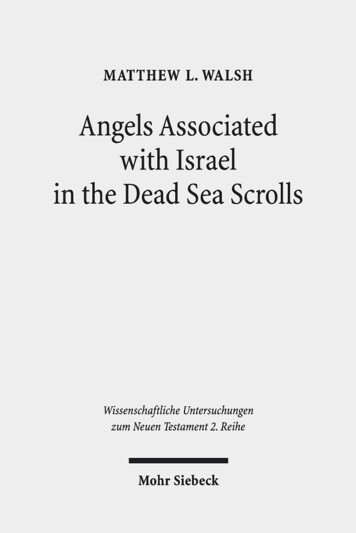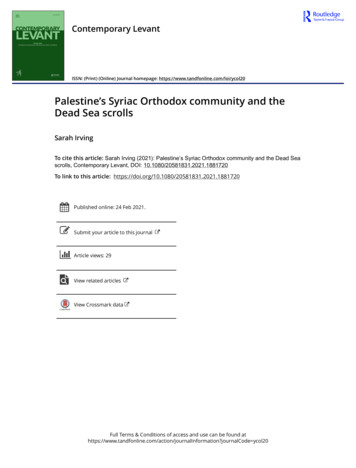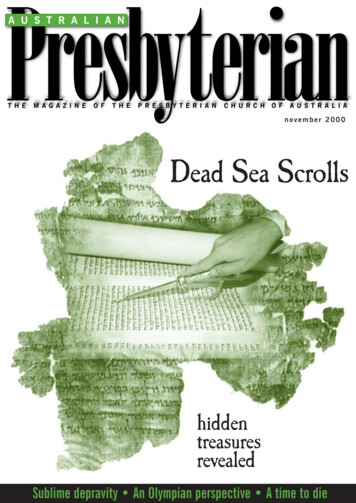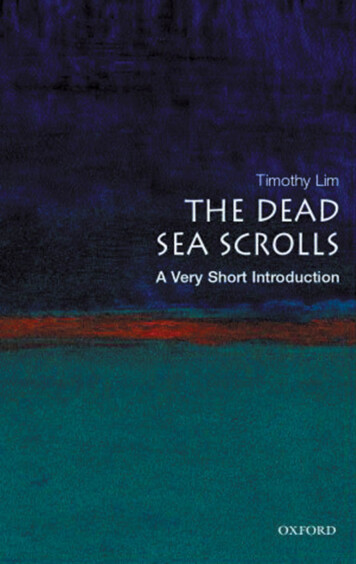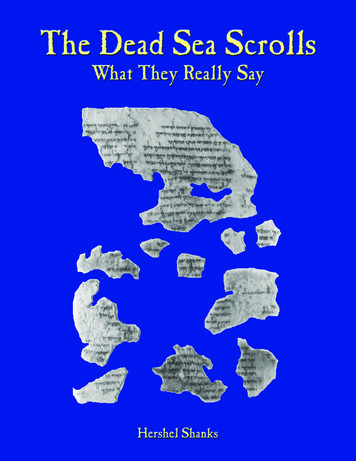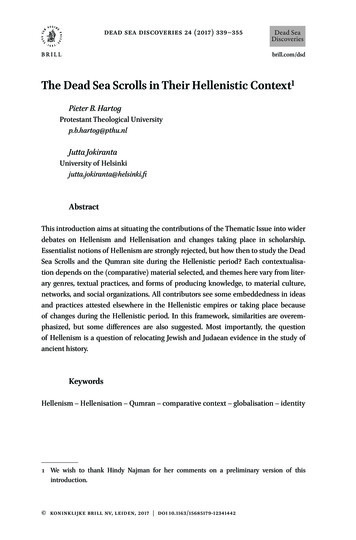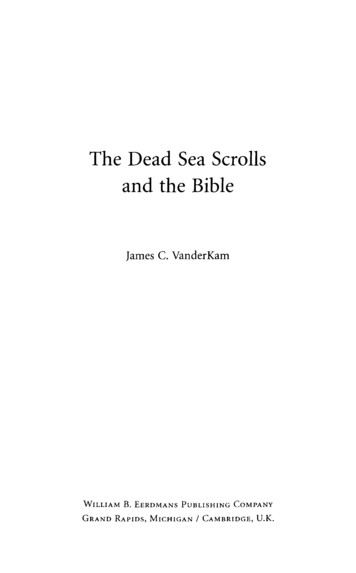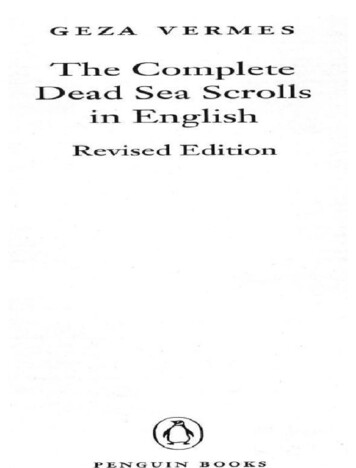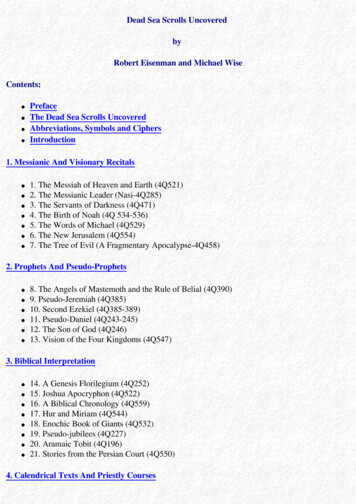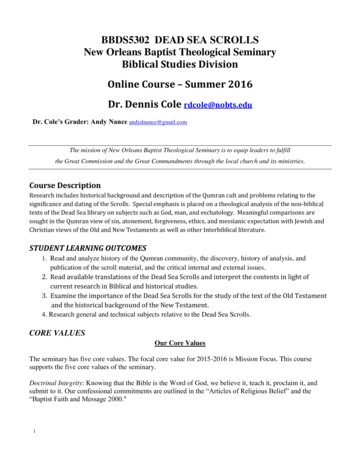
Transcription
BBDS5302 DEAD SEA SCROLLSNew Orleans Baptist Theological SeminaryBiblical Studies DivisionOnline Course – Summer 2016Dr. Dennis Cole rdcole@nobts.eduDr. Cole’s Grader: Andy Nance andydnance@gmail.comThe mission of New Orleans Baptist Theological Seminary is to equip leaders to fulfillthe Great Commission and the Great Commandments through the local church and its ministries.Course DescriptionResearch includes historical background and description of the Qumran cult and problems relating to thesignificance and dating of the Scrolls. Special emphasis is placed on a theological analysis of the non-biblicaltexts of the Dead Sea library on subjects such as God, man, and eschatology. Meaningful comparisons aresought in the Qumran view of sin, atonement, forgiveness, ethics, and messianic expectation with Jewish andChristian views of the Old and New Testaments as well as other Interbiblical literature.STUDENT LEARNING OUTCOMES1. Read and analyze history of the Qumran community, the discovery, history of analysis, andpublication of the scroll material, and the critical internal and external issues.2. Read available translations of the Dead Sea Scrolls and interpret the contents in light ofcurrent research in Biblical and historical studies.3. Examine the importance of the Dead Sea Scrolls for the study of the text of the Old Testamentand the historical background of the New Testament.4. Research general and technical subjects relative to the Dead Sea Scrolls.CORE VALUESOur Core ValuesThe seminary has five core values. The focal core value for 2015-2016 is Mission Focus. This coursesupports the five core values of the seminary.Doctrinal Integrity: Knowing that the Bible is the Word of God, we believe it, teach it, proclaim it, andsubmit to it. Our confessional commitments are outlined in the “Articles of Religious Belief” and the“Baptist Faith and Message 2000."1
Spiritual Vitality: We are a worshiping community emphasizing both personal spirituality and gatheringtogether as a Seminary family for the praise and adoration of God and instruction in His Word.Mission Focus: We are not here merely to get an education or to give one. We are here to change the worldby fulfilling the Great Commission and the Great Commandments through the local church and itsministries.Characteristic Excellence: What we do, we do to the utmost of our abilities and resources as a testimony tothe glory of our Lord and Savior Jesus Christ.TEXTBOOKSJodi Magness, The Archaeology of Qumran and the Dead Sea Scrolls (Eerdmans, 2002) AQDSSJames C. VanderKam. The Dead Sea Scrolls Today, rev. edition (Eerdmans, 2010) DSSTGeza Vermes, The Complete Dead Sea Scrolls in English (Penguin/Pelican, 2004) DSSEPeter Flint, editor. The Bible at Qumran: Text, Shape, and Interpretation.Studies in the Dead Sea Scrolls & Related Literature. (Eerdmans, 2001)Craig Evans, Holman Quick Source Guide to the Dead Sea Scrolls(Broadman & Holman, 2010)C. Evans & P. Flint, eds. Eschatology, Messianism, and the Dead Sea ScrollsBQTHQSEMDSSRecommended Texts:Lawrence H. Schiffman, Reclaiming the Dead Sea Scrolls (Doubleday)**Gabriele Boccaccini, Beyond the Essene Hypotheses (Eerdmans)**Hanan Eshel, The Dead Sea Scrolls and the Hasmonean State (Eerdmans)**J. Hayes, S. Mandel, The Jewish People in Classical Antiquity (Westminster/John Knox)E. Ulrich, The Dead Sea Scrolls and the Origins of the Bible (Eerdmans)**F.M. Cross and Shemaryahu Talmon, eds. Qumran and the History of the Biblical TextEmanuel Tov, Textual Criticism of the Hebrew Bible (2nd ed)(Fortress)**P. Wise, M. Abegg, E. Cook; The Dead Sea Scrolls: A New Translation (Harper-San Francisco)Florentino Martinez, The Dead Sea Scrolls Translated (Brill)M. Abegg, P. Flint, E. Ulrich; The Dead Sea Scrolls Bible (Harper-San Francisco)K. Stendahl, ed., The Scrolls and the New Testament (Crossroads)**J. Fitzmyer, The Dead Sea Scrolls and Christian Origins (Eerdmans)**J. Charlesworth, ed., John and the Dead Sea Scrolls (Crossroads)**J. Charlesworth, ed., Jesus and the Dead Sea Scrolls (Doubleday)**J. Charlesworth & J. Murphy-O'Connor, eds., Paul and the Dead Sea Scrolls (Crossroads) OP**Weston Fields, The Dead Sea Scrolls: A Short History (Brill, 2006)2
COURSE EVALUATION:Evaluation at the end of the internet semester or summer term will be done of the basis of the followingpercentages:(1) Mid Term Exam20%Grade Scale(2) Research Paper25%A93-100(3) Book Reviews (2) 10% each20%B85-92(4) Discussion Board10%C78-84(5) Final Exam25%D70-78FBelow 70RESEARCH PAPERThe student will complete a research paper of 15-20 pages in length, inclusive of Bibliography on aselected topic related to the Dead Sea Scrolls and the relationship to the Old and New Testaments. The papermust include references to journal articles / periodical literature in footnotes/endnotes to achieve a highergrade. The seminary web page provides access to online books and periodical literature through the NOBTSLibrary section of our web site.See the EBSCO Online research section of the “Course Documents” on Blackboard for access identification andpassword for this site for accessing this type of material. Also note that “Google Books” also may provideaccess to full documents for your research.The research paper should be written in either Turabian, SBL, or APA style. In addition to the basic content ofthe paper, the presentation should include the following:Cover PageFootnotes or End NotesTable of ContentsSelected Bibliography (at least 15 entries)SAMPLE RESEARCH PAPER TOPICS1.2.3.4.5.6.7.8.9.10.11.12.13.3Baptism in Qumran and ChristianityDualism at QumranThe "Works of the Law" in the Qumran DocumentsSpiritual Refinement in the Wilderness (Separatism)The Concept of Messiah in Qumran and the New TestamentHermeneutics in Qumran and the New TestamentThe Excavation of Qumran and Ein FeshkaThe Dating of the Dead Sea ScrollsThe Historical Background of the Qumran Community,, 200 B.C.-73 A.D.The Identification of the Qumran sectThe Qumran Solar Year and the Lunar Judaic CalendarDaily Life and Ritual at QumranThe Dead Sea Scrolls and the Text of the Old Testament
.31.32.33.34.35.The Dead Sea Scrolls and the Use of the Old Testament in the New TestamentThe Communal Meal at Qumran and Christian CommunionThe Writings of Philo, Pliny the Elder, and Josephus Concerning the EssenesThe Exploration and Excavation of the Dead Sea Region (excluding Qumran)The Relationship of Qumran Sect to Sectarian JudaismThe Teacher of Righteousness and the Wicked Priest in the Dead Sea ScrollsThe Concept of God in the Qumran TextsThe Concept of Man in the Qumran TextsQumran Texts and the Teaching of JesusQumran Texts and the Teaching of PaulQumran Texts and the Teaching of John the BaptistQumran Texts and the Teaching of the Apostle JohnThe Psalms ScrollThe War ScrollThe Damascus Document and Essene BeginningsThe Temple ScrollThe Copper ScrollThe Rule of the Community4QMMTThe Paleo-Hebrew Leviticus ScrollDeterminism in the Teaching and Literature of the Qumran ScrollsLaws of Purity and Ritual Purification in the Dead Sea ScrollsSUGGESTED JOURNALS FOR RESEARCH BIBLIOGRAPHYBiblical ArchaeologistNear Eastern Archaeology (formerly BA)Revue de QumranJournal of Biblical LiteratureBiblical IllustratorPalestine Exploration QuarterlyIsrael Exploration JournalArchaeologyBible ReviewBiblical Archaeology ReviewJournal of Jewish StudiesJournal of the Evangelical Theological SocietyBulletin for Biblical ResearchSouthwest Journal of TheologyBulletin of the American Schools of Oriental ResearchZeitschrift f r die altentestamentliche Wissenschaft4
COURSE SCHEDULE SUMMER 2016WEEK I MAY 30—JUNE 5UNIT I INTRODUCTION: DISCOVERY OF THE DEAD SEA SCROLLS In this unit, the student will:Read a summary of the discovery of the Dead Sea Scrolls in 1946-47Study the early accounts of the distribution of the scrolls and discovery of the cave areaUnderstand the political situation in the post-World War II era and the founding of the State of IsraelStudy the stages and persons involved in the collection & purchasing of the Dead Sea Scrolls, theirassessment and authenticationRead HQS, Part I, chs. 1-4Read DSST, 1-20Read DSSE, 1-12Read AQDSS, 1-31For a detailed reference work on the sequence of events related to the discovery and study of the DeadSea Scrolls from 1946-1967, see Weston Fields, The Dead Sea Scrolls: A Short History (Brill, 2006), or evenmore detailed his The Dead Sea Scrolls: A Full History (Brill, 2009).View YouTube video: http://www.youtube.com/watch?v aF3z4FcZegAView on Blackboard, PowerPoint: “Khirbet Qumran and the Dead Sea Scrolls”DISCUSSION BOARD #1PERSONAL INTRODUCTION (see Blackboard posting)WEEK II JUNE 5-11UNIT II ARCHAEOLOGY OF KHIRBET QUMRAN AND THE DEAD SEA SCROLLS In this unit, the student will:Read the accounts of the archaeological excavation of the site of Khirbet Qumran by Roland DeVaux,plus later excavations by various scholarsDiscern some of the variations on the interpretation of the buildings and other finds at thearchaeological site at Khirbet QumranInterrelate the excavated finds with the historical setting of the Qumran sectariansRead DSST, 20-32Read AQDSS, 32-104Video clip from YouTube: “Unlocking the Dead Sea Scrolls” -- See Unit II on Blackboard5
WEEK IIUNIT III AUTHENTICITY AND DATING OF THE DEAD SEA SCROLLSIn this unit, the student will: Examine the steps and processes taken to authenticate the Dead Sea Scrolls after theirdiscovery and initial distribution Investigate the palaeographical methods and other means for dating the scrolls Study the various types of literature found among the broad corpus of literature in theDead Sea ScrollsRead DSST, Dating Methods: 33-46, Survey of Manuscripts: 47-96Read HQS, Part II, chs. 5-6; Part IV, chs. 11-13View video: http://www.youtube.com/watch?v JAi7ZDY2q4s&feature relatedWEEK III JUNE 12-18UNIT IVTHE HISTORICAL BACKGROUND & IDENTITY OF THE QUMRANSECTARIANS B SELF IDENTITY In this unit, the student will:Study the historical background and setting of the sectarians at Khirbet Qumran by the DeadSeaExamine the data relative to identifying the Qumran sectariansDiscern the relative probability of identifying the Qumran sectarians with one of the knownreligious and political parties of Second Temple JudaismRead HQS, Part III, chs. 7-10; Part V, chs. 14-17Read DSST, 97-126Read DSSE, chapters II - III: 26-66, Damascus Document 127-130DISCUSSION BOARD #2 Qumran Sectarian Identity “Discuss the relative probability of theidentity of the Qumran sectarians with the Essenes as described by the historians andphilosophers Flavius Josephus, Philo of Alexandria, and Pliny the Elder.” This discussionshould also be based upon the archaeological findings as well the internal allusions andattestations within the scrolls themselves.WEEK IIIUNIT V LIFE IN THE COMMUNITY AT KHIRBET QUMRANIn this unit, the student will: Examine the daily life activities of the Qumran sectarians Study the lifestyle philosophy of the Qumran sectarians Investigate the steps and process of becoming a member of the Qumran sectRead DSSE, 97-156 "Community Rule" and "Damascus Document"6
Read DSSE, 220-239 Various Laws and IdeologiesDISCUSSION BOARD # 3 Discuss the role of the Sabbath at Qumran, with itsvarious regulations cited in the Community Rule and the Damascus Document, andcompare these with the statements by Jesus in the Gospels regarding the role of theSabbath in Jewish life.WEEK IV JUNE 19-25UNIT VIRELIGIOUS LIFE AT KHIRBET QUMRANIn this unit, the student will: Examine the theological foundations and presuppositions of the Qumran sectarians Assess dualistic philosophy of the Qumran sectarians Assess the deterministic theology of the sectRead DSSE, 67-90 "The Religious Ideas of the Community"Read HQS, Part VI, chs 18-21Read DSST, 137-156 “Sketch of Qumran Thought”Read AQDSS, 105-162View YouTube documentary from National Geographichttp://www.youtube.com/watch?v eFPH8BY0miE***MID-TERM EXAM***DUE JULY 1The MidTerm Exam should be taken after completing all of the assignments inUnits I through VI. The deadline for taking the MidTerm Exam is JULY 1WEEK IVUNIT VII MESSIANISM & MESSIANIC HOPE IN THE DEAD SEA SCROLLSIn this unit, the student will: Examine the eschatological vantage point of the Qumran sectarians Read texts highlighting the personages of messianic hope Discern issues relative to varied interpretive viewpoints of single and multiple messianicfigures in the scrollsRead DSSE, "Messianic Rule, War Scroll," 157-189;"Apocalyptic Works," 387-394Read DSST, 215-226 “Eschatology”Read HQS, Part VIII, chs. 26-27DISCUSSION BOARD #4 : Did the Qumran sectarians hold to a singular concept of Messiahor multiple messianic figures? Include references to Biblical and sectarians literature insupport of your viewpoint. How does this inform our understanding of Jesus as Messiah aspresented in the New Testament?7
WEEK V JUNE 26—JULY 2UNIT VIIITHE FUTURE TEMPLE & THE TEMPLE SCROLLIn this unit, the student will: Examine the Qumran sectarian view of the Second Temple and its leadership Investigate the literary character of the Temple Scroll Discern the eschatological perspective of the Temple ScrollRead DSSE 190-219 "Temple Scroll"WEEK V / UNIT IX THE TEXT OF THE BIBLE IN THE DEAD SEA SCROLLS In this unit, the student will:Assess the representation of the Biblical texts at Qumran, which books & how many copiesExamine the palaeography of the Biblical texts at QumranAssess the orthography (spelling practices) represented in the various Qumran scrollsBegin to evaluate the status of the Biblical canon at QumranUnderstand the contribution of the Dead Sea Scrolls to our knowledge of the history of the Biblical textRead: HQS, Part VII, chs. 22-24Read: DSST, 157-197Book Review: Review one of the following books:E. Ulrich, The Dead Sea Scrolls and the Origins of the Bible (Eerdmans)**F.M. Cross and Shemaryahu Talmon, eds. Qumran and the History of the Biblical Text**Emanuel Tov, Textual Criticism of the Hebrew Bible (2nd ed)(Fortress)**DISCUSSION BOARD #5 In light of your study of nature and status of the Biblical text at Qumran, what do youunderstand to be the meaning of the statement of Jesus in Matthew 5:17-18?WEEK VI JULY 3-9UNIT X QUMRAN HERMENEUTICS: BIBLE INTERPRETATION IN THE DEADSEA SCROLLSIn this Unit the student will: Examine the nature of Biblical Interpretation evidenced in the Qumran literature Investigate the use of the Bible in the sectarian literature of the Dead Sea Scrolls Assess the methodology of interpretation utilized in the Biblical commentaries at QumranRead the following article: “Rhetoric and Hermeneutics in Miqsat Ma ase ha-Torah (4QMMT):The Case of the Blessings and Curses” by Steven D. Fraade (Yale University)8
?vid 5&hid 125&sid 0BOOK REVIEW #2Choose from the books marked with a double asterisk ** for the 2nd book review.WEEK VI / UNIT XI THE RABBIS, NEW TESTAMENT, & QUMRANINTERPRETATION In this unit, the student will:Compare the Hermeneutical principles of Qumran with that of emerging rabbinical JudaismCompare the Hermeneutical principles of Qumran with those of the New TestamentInvestigate New Testament examples of 1st century hermeneutical methodsSee handout on the interpretive methodologies of Hillel and Rabbi Ishmael.Read the following articles via the seminary online library research on EBSCO:"Hermeneutical Systems of Hillel and the Tannaim: A Fresh Look" by W. SIBLEY TOWNERUnion Theological Seminary, Richmond, dfviewer?vid 4&hid 125&sid 0“4QMMT, RABBI ISHMAEL, AND THE ORIGINS OF LEGAL MIDRASH” by AZZAN YADINRutgers /pdfviewer?vid 5&hid 125&sid 0See Lecture by Lawrence Schiffman athttp://www.youtube.com/watch?v 92hyhBXLaWE&feature relatedDISCUSSION BOARD #6 In light of your study of nature and status of the Biblical text at Qumran, what doyou understand to be the meaning of the statement of Jesus in the Gospel of Matthew9
WEEK VII JULY 10-16UNIT XIIJESUS, THE EARLY CHURCH, AND THE QUMRAN SECTARIANSIn this unit, the student will: Compare daily practices of Qumran and the Early ChurchCompare teachings of Jesus and those of Qumran sectariansCompare the life of Jesus with the Teacher of RighteousnessRead DSST, 197-215See Handouts noted in Blackboard Unit XIIView 3 videos on the relationship between Dead Sea Scrolls and the Early ChurchDISCUSSION BOARD #7Compare Jesus teaching on interpersonal relationships in the world and theteaching of the Qumran sectarians on its relationship to the world.WEEK VII / UNIT XIII JOHN THE BAPTIST AND THE QUMRAN SECTIn this unit the student will: Probe the life of John the Baptist as revealed in the Gospels of the New Testament Compare the New Testament passages about John the Baptist with materials from the Dead Sea Scrolls Examine the lives of John's parents Zacharias and Elizabeth against the backdrop of sectarian JudaismReading AssignmentsRead DSST, 206-210Read HQS, Part VIII, ch. 25Read C. Evans & P. Flint, eds. Eschatology, Messianism, and the Dead Sea ScrollsDISCUSSION BOARD #8 Discuss the plausibility of John the Baptist having been a member of the Qumransect for a period of time prior to his public ministry that is described in John 1 and other NT texts.View YouTube video clip: http://www.youtube.com/watch?v CwWmNT2a7H0Read ct/10
WEEK VIII JULY 17-22UNIT XIVTHE APOSTLES JOHN & PAUL AND THE DEAD SEA SCROLLS In this unit the student will:Examine the theology of John the Apostle in relation to the teachings in the Dead Sea ScrollsCompare the teachings of the Apostle Paul with that of the Qumran sectariansExamine the relative theological determinism of Qumran sectarians with that of the ApostlePaulRead HQS, Part IX, chs. 28-31Read 2 journal articles each ( 2 on John, 2 on Paul) or chapters in books on the relationshipbetween the teaching of John and Paul and that of the Qumran sectariansRESEARCH PAPER DUE JULY 22FINAL EXAM – ESSAYS DUE JULY 22SELECTED BIBLIOGRAPHYAbegg, M.G., Jr., P. W. Flint, and E. Ulrich. The Dead Sea Scrolls Bible. New York: HarperSanFrancisco, 1999.Albright, William F. The Scrolls and Christianity. London, Society for Promoting ChristianKnowledge, 1969.Allegro, John M. The Dead Scrolls. Harmonsworth: Penguin/Pelican, 1956. The Dead Sea Scrolls and the Origins of Christianity. NY: Chriterion Books, 1957. The Dead Sea Scrolls: A Reappraisal. Baltimore: Penguin/Pelican, 1956, 1964. The People of the Dead Sea Scrolls in Text and Pictures. The Treasure of the Copper Scroll. 2nd ed. Garden City, NY: Anchor Books, 1964.Anderson, Robert T. and Terry Giles. The Keepers: An Introduction to the History and Culture ofthe Samaritans. Peabody, MA: Hendrickson Publishers, 2002.Badia, Leonard. The Dead Sea People's Sacred Meal and Jesus' Last Supper. Washington:University Press of America, 1979. The Qumran Baptism and John the Baptist's Baptism. Lanham, MD: University Pressof America, 1980.Barthelemy, D. and Milik, J.T. Discoveries in the Judean Desert I. Oxford: University Press, 1955.Bartlett, J.R. Jews in the Hellenistic World: Josephus, Aristeas, Sybilline Oracles, Epolemus.Cambridge Commentary on Writings of the Jewish and Christian World 200 BC-AD 200.vol. 1, pt. 1. NY: Cambridge University Press, 1985.Baumgarten, Joseph M. Studies in Qumran Law. Leiden: E.J. Brill, 1977.Birnbaum, Solomon. The Qumran Scrolls and Paleography. BASOR Supplement Series, 13,14.New Haven, CT: American Schools of Oriental Research, 1952.Black, Matthew, ed. The Scrolls and Christianity. London: SPCK, 1969. The Scrolls and Christian Origins. London: Thomas Nelson & Sons, 1961.11
Boccaccini, Gabriele. Beyond the Essene Hypothesis: the Parting of the Ways Between Qumranand Enochic Judaism. Grand Rapids: Eerdmans, 1999. Ed. Enoch and Qumran Origins: New Light on a Forgotten Connection. Grand Rapids:Eerdmans, 2005.Brooke, George J. Exegesis at Qumran: 4Q Florilegium in Its Jewish Context. JSOT Supplement 29.Sheffield: Univ. of Sheffield, 1985., ed. Temple Scroll Studies. Sheffield: Academic Press, 1989.Brownlee, William H. The Dead Sea Manual of Discipline. BASOR Supplement #10-12. New Haven,CT: American Schools of Oriental Research, 1951. The Meaning of the Qumran Scrolls for the Bible With Special Attention to the Book of Isaiah.NY: Oxford University Press, 1964.Bruce, F.F. Biblical Exegesis in the Qumran Texts. Grand Rapids: Eerdmans, 1959. Second Thoughts on the Dead Sea Scrolls. Grand Rapids: Eerdmans, 1956. The Teacher of Righteousness in the Qumran Texts. London: Tyndale, 1956.Burchardt, Christoph. Bibliographie Zu den Handschriftenvom Toten Meer. Beihefte zurZeitschrift fur die Alttestamentlicche Wissenschaft, #76. Berlin: Verlag Alfred Topelmann, 1959.Cansdale, L. Qumran and the Essenes: A Re-evaluation of the Evidence. Tubingen: JCB Mohr, 1997.Charlesworth,, James H, with R.E. Brown and J.L. Price, eds. John and Qumran. London: GeoffreyChapman, 1972.Charlesworth, J.H., ed. The Dead Sea Scrolls. Vol. 1, Rule of the Community and Related Documents.Louisville: Westminster/John Knox, 1993. The Dead Sea Scrolls. Vol. 2, Damascus Document, War Scroll, and Related Documents.Louisville: Westminster/John Knox, 1995. The Dead Sea Scrolls. Vol. 4A, Pseudepigraphic and Non-Masoretic Psalms & Prayers.Louisville: Westminster/John Knox, 1997. Graphic Concordance to the Dead Sea Scrolls. Forward by Martin Hengel. Louisville:Westminster/John Knox, 1997.Collins, Adela Y. and John Collins. King and Messiah as Son of God: Divine, Human, and Angelic MessianicFigures in Biblical and Related Literature. Grand Rapids: Eerdmans, 2008.Collins, John J. The Apocalyptic Imagination. NY: Crossroads, 1985. The Scepter and the Star: The Messiahs of the Dead Sea Scrolls and Other AncientLiterature. Anchor Bible Reference Series. New York: Doubleday, 1995.Collins, John J. and Robert A. Kugler, eds. Religion in the Dead Sea Scrolls. Grand Rapids: EerdmansPublishing, 2000.Cross, Frank Moore. The Ancient Library of Qumran and Modern Biblical Studies. NY: GreenwoodReprint, 1973, 1986. Scrolls from the Wilderness on the Dead Sea. San Francisco: ASOR, 1969.Cross, F.M. and Shemaryahu Talmon. Qumran and the History of the Biblical Text. Cambridge, MA:Harvard Univ. Press, 1975.Cross, F.M.; Freedman, D.N. and Sanders, J. A. Scrolls from Qumran Cave I. Jerusalem: AlbrightInstitute of Archaeological Research, 1974.Davies, Philip R. The Damascus Covenant: An Interpretation of the "Damascus Document".Sheffield: JSOT Supplement #25, 1983. Qumran. Cities of the Biblical World. Grand Rapids: Eerdmans, 1984.Driver, G.R. The Judean Scrolls. NY: Schocken Books, 1965.12
Dupont-Sommer, Andre. The Dead Sea Scrolls. Trans. by E. Margaret Rowley. New York:Macmillan, 1952. The Essene Writings from Qumran. Trans. by Geza Vermes. Oxford: Basil Blackwell, 1961. The Jewish Sect of Qumran and the Essenes. Trans. by R.D. Barnett. New York: MacmillanCo., 1956.Eisenman, Robert. James the Just in the Habakkuk Pesher. Leiden: Brill, 1986. Maccabees, Zadokites, Christians and Qumran: A New Hypothesis of Qumran Origins.Studia Post-Biblica 34. Leiden: E.J. Brill, 1983.Estrada, David and William White, Jr. The First New Testament. Nashville: Thomas Nelson, 1978.Eshel, Hanan. The Dead Sea Scrolls and the Hasmonean State. Studies in the Dead Sea Scrolls andRelated Literature. Grand Rapids: Eerdmans, 2008Evans, Craig and Peter Flint, eds. Eschatology, Messianism, and the Dead Sea Scrolls. Grand Rapids:Eerdmans, 1999.Fishbane, Michael. Biblical Interpretation in Ancient Israel. New York: Oxford Univ. Press, 1986.Fishbane, M., E. Tov, with W. W. Fields, Sha'arei Talmon : Studies in the Bible, Qumran, and theAncient Near East presented to Shemaryahu Talmon. Winona Lake, IN : Eisenbrauns, c1992.Fitzmyer, Joseph A. The Dead Sea Scrolls: Major Publications and Tools for Study. Missoula, MT:Scholars Press, 1975. The Dead Sea Scrolls and Christian Origins. Grand Rapids: Eerdmans, 2000. The Genesis Apocryphon of Qumran Cave I. Rome: Pontifical Biblical Institute, 1966.Flint, Peter, ed. The Bible at Qumran: Text, Shape, and Interpretation. Grand Rapids: Eerdmans, 2001.Flint, Peter, and J .Vanderkam. The Dead Sea Scrolls after Fifty Years: A Comprehensive Assessment.2 vols. Boston: E.J. Brill, 1998.Forkman, Goran. The Limits of the Religious Community: Expulsion from the Religious Communitywithin the Qumran Sect, within Rabbinic Judaism and within Primitive Christianity. Lund, Sweden:Gleerup, 1972.Fritsch, Charles T. The Qumran Community. NY: Macmillan, 1956.Gartner, Bertil. The Temple and the Community in Qumran and the New Testament: A ComparativeStudy in the Temple Symbolism Qumran Texts and the New Testament. Cambridge: University Press,1965.Gaster, Theodor. The Dead Sea Scriptures. 3rd ed. Garden City: Doubleday/Anchor, 1976.Gilliam, Olive K. Qumran and History: The Place of the Teacher in Religion. NY: Vantage Press, 1974.Habermann, A.M. Megilloth Midbar Yehuda: The Scrolls from the Judean Desert. Jerusalem:Machbaroth Lesifrut Publishing House, 1959.Harrison, Hannah. Impurity Systems of Qumran and the Rabbis. SBL Diss. Atlanta: SBL, 1993.Henze, Matthias, ed. Biblical Interpretation at Qumran. Studies in the Dead Sea Scrolls and RelatedLiterature. Grand Rapids: Eerdmans, 2005.Hirschfeld, Yizhar. Qumran in Context: Reassessing the Archaeological Evidence. Peabody, MA:Hendrickson Publishers, 2004.Holm-Nielsen, Svend. Hodayot: Psalms from Qumran. Copenhagen: Universitetsforlaget Iaarhus, 1960.Jongeling, B., C.J. Labuschagne and A.S. van der Woude. Aramaic Texts for Qumran: WithTranslation and Annotations. Leiden: E.J. Brill, 1976.Kittel, Bonnie. The Hymns of Qumran: Translation and Commentary. SBL Dissertation Series 50.Chico: Scholars Press, 1981.Kobelski, Paul J. Melchizedek and Melchiresah. CBQ Monograph Series vol. 10. Catholic Biblical13
Association. Washington: Catholic University of America, 1981.Kosmala, Hans. Hebraer, Essener, Christen: Studien zur Vorgeschichte der fruchristlichen.Leiden: E.J. Brill, 1959.La Sor, William S. The Amazing Dead Sea Scrolls and the Christian Faith. Chicago: Moody Press,1956. Bibliography of the Dead Sea Scrolls 1948-1957. Fuller Theological SeminaryBibliographical Series #2. Pasadena: Fuller Theological Seminary, 1960. The Dead Sea Scrolls and the New Testament. Grand Rapids: Eerdmans, 1972.Larson, Martin. The Essene Heritage. NY: Philosophical Library, 1967.Leaney, A.R.C. The Rule of Qumran and Its Meaning. London: SCM Press, 1966.Licht, Jacob. "An Analysis of the Treatise of the Two Spirits in the Dead Sea Documents," in ScriptaHierosolymitana. Ed. by Chaim Rabin and Yigael Yadin. Jerusalem: The Magnes Press, 1965.Lichtenberger, H. Studien zum Menschenbild in Testen der Qumrangemeinde. Gottingen: Vanderhoeck& Ruprecht, 1980.Longenecker, Richard. Biblical Exegesis in the Apostolic Period. Grand Rapids: Eerdmans, 1975.Magness, Jodi. The Archaeology of Qumran And the Dead Sea Scrolls. Grand Rapids: Eerdmans, 2002. Debating Qumran: Collected Essays on Its Archaeology. Interdisciplinary Studies inAncient Culture and Religion. Peters, 2003.Maier, Johann. The Temple Scroll: An Introduction, Translation and Commentary. JSOTSupplement 34. Sheffield: Univ. Press, 1985.Mansoor, Menahem. The Dead Sea Scrolls. Grand Rapids: Eerdmans, 1964. The Thanksgiving Hymns. Grand Rapids: Eerdmans, 1961.Martin, Malachi. The Scribal Character of the Dead Sea Scrolls. 2 Vols. Louvain, France: PublicationsUniversitaires, 1958.Martinez, F.G. The Dead Sea Scrolls Study Set. 2 vols. Grand Rapids: Eerdmans, 1999.Medico, H.E. del. The Riddle of The Scrolls. Trans. by H. Gardner. NY: Robert M. McBride, 1959.Merrill, Eugene. Qumran and Predestination: A Theological Study of the Thanksgiving Hymns.Leiden: E.J. Brill, 1975.Milik, J.T. Ten Years of Discovery in the Wilderness of Judea. Studies in Biblical Theology, #26.Trans. by J. Strugnell. London: SCM Press, 1959. The Books of Enoch: Aramaic Fragments of Qumran Cave 4. Oxford: University Press,1976.Mowry, Lucetta. The Dead Sea Scrolls and the Early Church. Chicago: Univ. of Chicago Press, 1962.Murphy-O'Connor, Jerome. Paul and Qumran: Studies in New Testament Exegesis. London: GeoffreyChapman, 1968.Patte, Daniel. Early Jewish Hermeneutic in Palestine. Missoula: Scholars Press, 1975.Pfeiffer, Charles F. The Dead Sea Scrolls and the Bible. Grand Rapids: Baker Book House, 1969.Ploeg, J.P.M. van der. The Excavations at Qumran. Trans. by Keven Smyth. London: Longmans andGreen, 1958. Le Rouleau de la Guerre. Leiden: E.J. Frill, 1959.Przybylski, Benno. Righteousness in Matthew and His World of Thought. Cambridge: CambridgeUniversity Press, 1980.Ringgren, Helmer. The Faith of Qumran. Trans. by Kevin Smyth. London: Longmans and Green, 1958.Roth, Cecil. The Historical Background of the Dead Sea Scrolls. Oxford: Basil Blackwell, 1958.Rowley, H.H. The Dead Sea Scrolls and the New Testament. London: The Sidney Press Ltd., 1957.14
. Jewish Apocalyptic and the Dead Sea Scrolls. London: Athlone, 1957. Zadokite Documents and the Dead Sea Scrolls. Oxford: Basil Blackwell, 1952.Sanders, James A. The Dead Sea Psalms Scroll. Ithaca, NY: Cornell University, 1967. The Psalms Scroll of Qumran Cave 11. Oxford: Clarendon Press, 1965.Sanderson, Judith. An Exodus Scroll from Qumran: 4Qpaleo Exodm and the Samaritan Tradition.Harvard Semitic Studies, 30. Cambridge: Harvard University Museum, 1986.Scharlemann, Martin. Qumran and Corinth. NY: Bookman Assoc., 1962.Schiffman, Laurence. Reclaiming the Dead Sea Scrolls. New York: Doubleday, 1994. Sectarian La
5 COURSE SCHEDULE SUMMER 2016 WEEK I MAY 30—JUNE 5 UNIT I INTRODUCTION: DISCOVERY OF THE DEAD SEA SCROLLS In this unit, the student will: Read a summary of the discovery of the Dead Sea Scrolls in 1946-47 Study the early accounts of the distribution of the scrolls and discovery of the cave area Understand the political situation in the post-World War II era and the founding of the State of .
